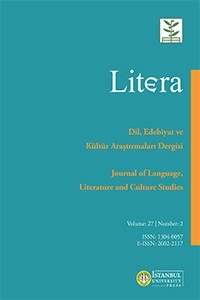THE CHALLENGES OF TRANSLATING THE METAMORPHIC FEMALE IMAGE IN ELIZABETH SMART'S NOVELS
Translation of gendered language, once a text-linguistic concern, has started to attract the attention of translation scholars and critics from a more comprehensive and up-to-date point of view, namely the discursive aspects of gender and the sociolinguistic dimension of a translated text. There seems to be a growing need for further investigation on gendered discourse as representation of an extra-linguistic structure which emerges through the manipulation or exploitation of discursive and stylistic means for the purpose of creating either a group or an ideology-based language/discourse sample. The gender of the author and the translator, limiting the discussion to female gender, occupy the minds of the feminist researchers and discourse analysts as factors to be evaluated in terms of the process and the product. The feminist attitudes developed for the reading, interpretation and translation of literary texts have their impact on the discussion frame of the present study as well'. Still, the impact of feminism as an ideology to be pursued textually will be limited here with the clues explicitly rendered through the sample texts as the representation of a possible feminist attitude of the author.
Anahtar Kelimeler:
CHALLENGES, TRANSLATING, METAMORPHIC
THE CHALLENGES OF TRANSLATING THE METAMORPHIC FEMALE IMAGE IN ELIZABETH SMART'S NOVELS
Translation of gendered language, once a text-linguistic concern, has started to attract the attention of translation scholars and critics from a more comprehensive and up-to-date point of view, namely the discursive aspects of gender and the sociolinguistic dimension of a translated text. There seems to be a growing need for further investigation on gendered discourse as representation of an extra-linguistic structure which emerges through the manipulation or exploitation of discursive and stylistic means for the purpose of creating either a group or an ideology-based language/discourse sample. The gender of the author and the translator, limiting the discussion to female gender, occupy the minds of the feminist researchers and discourse analysts as factors to be evaluated in terms of the process and the product. The feminist attitudes developed for the reading, interpretation and translation of literary texts have their impact on the discussion frame of the present study as well'. Still, the impact of feminism as an ideology to be pursued textually will be limited here with the clues explicitly rendered through the sample texts as the representation of a possible feminist attitude of the author.
Keywords:
CHALLENGES, TRANSLATING, METAMORPHIC,
___
- Bulut, Alev. 1999. "Female-Gendered Word Fields in Translation: Turkish-English Gender
- Rhetorics Contrasted" paper submitted at British Center for Literary Translation Gender
- a11d Li1era1y Translalion Symposium. 17-19 December, 1999, Norwich, United Kingdom. Mills, Sarah, L. Pearce eta!. 1989. Fe111inisl Readings, Feminisls Reading. New York: Harvester. Wheatsheaf.
- Simon, Sherry. 1996. Ge11der in Translation. London: Routledge.
- Smart, Elizabeth. 1991 . /Jy Gra11d Cenlral S!ation I Sat Down and Wept.London: Paladin/ Harper Collins.
- Smart, Elizabeth. 1991. The Assumption of Rogues and Rascals.London: Paladin/Harper Collins.
- von Flotow, Luise. 1997. Translation and Gender. Manchester: St. Jerome Publishing.
- Başlangıç: 1954
- Yayıncı: İstanbul Üniversitesi
Sayıdaki Diğer Makaleler
E. L. DOCTOROW'S THE BOOK OF DANIEL: TOWARDS A POSTMODERN CONCEPTION OF JUSTICE
WOMAN AS NOMAD: AN ALTERNATIVE CONFIGURATION OF FEMALE SUBJECTIVITY
YAPISALCILIK SONRASI YAKLAŞIMLAR VE ÇEViRiBiLiM
THE DISSOLUTION OF VALUE AND MEANING IN JOHN BARTH'S THE FLOATING OPERA
THE ARMADA PORTRAIT: COSTUME AND THE BODY POLITIC
A UNIQUE GENRE IN ENGLISH LETTERS: THE MEMOIRS OF OTTOMAN WOMEN
iVAN GONÇAROV: OBLOMOV'UN DÜNYASINA BiR BAKIŞ
RUS YAZININDA "SLAVCILIK" DÜŞÜNCESi
THE TRUTH, THE WHOLE TRUTH': THE RELATION OF PARTS TO THE WHOLE IN THE RING AND THE BOOK
